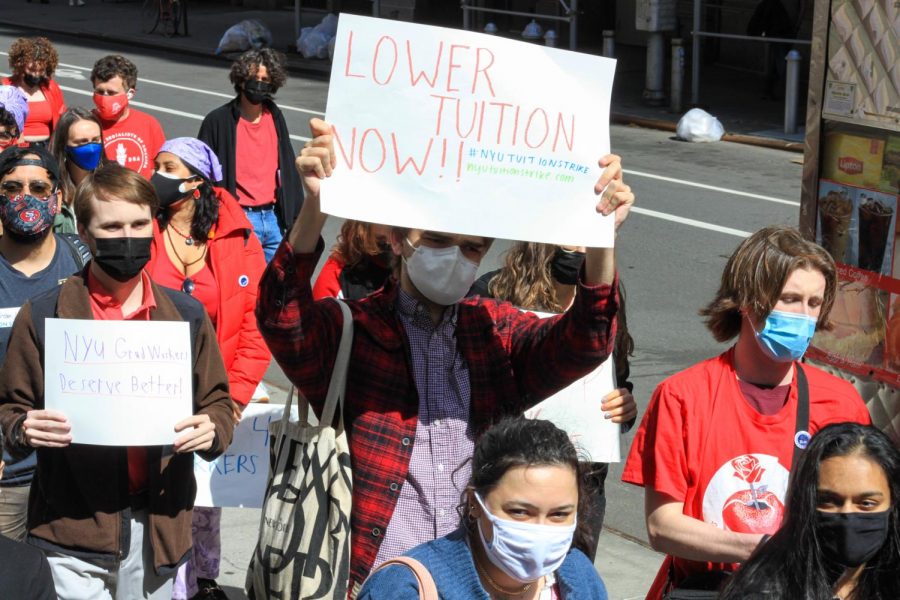NYU YDSA leaders reflect on tuition strike failures
In interviews with WSN, NYU YDSA leaders said the failure of their tuition strike effort resulted from inexperienced leadership taking on a project that was far too ambitious.
NYU’s chapter of YDSA attempted to organize a tuition strike. Despite their efforts, the planned strike was called off. (Staff Photo by Alexandra Chan )
November 19, 2021
After cancelling plans for a spring 2022 semester tuition strike, members of the NYU chapter of the Young Democratic Socialists of America met on Nov. 12 to reflect on the strike’s foundering and to pivot their organizing toward other issues and actions.
Organizers at NYU YDSA said the group’s efforts will continue, and that the chapter’s commitment to the goals outlined in their original set of strike demands has not changed. In the days following the strike’s cancellation, the chapter released a statement pointing toward Sunrise NYU’s campaign for divestment as a new direction for its on-campus activities, and co-organized a rally for divestment with the organization.
Speaking to WSN, chapter leaders attributed the strike’s failure to the lack of a developed base of support, the inexperience of its organizers and the absence of clear channels of communication with the student body.
Turnover in leadership
CAS sophomore Erin Lawson, who is co-chair of the NYU YDSA, said that turnover in the group’s leadership made developing a campaign of this magnitude more difficult than expected.
“We organized the strike in the spring intending for it to happen in fall 2021 initially, and then the leadership turnover happened,” Lawson said. “Keeping a major campaign running is labor-intensive and exhausting, and it was just a bit chaotic.”
Unlike national political organizations, student groups often do not have years to plan and build toward a single long-term action, since their senior-most members graduate and leave each year.
Organizational inexperience
Most students involved in the campaign were first-time organizers with little to no experience organizing on campus, according to NYU YDSA leaders.
NYU YDSA campaign coordinator Karishma Chari, a CAS junior, said that while new organizers have a lot of potential, they need time and experience to develop the skills and the confidence to take on larger actions, like campaigning to reach the critical mass of 5,000 students that NYU YDSA said it needed in order to go on strike.
“When you take on a big campaign like this, or just in strikes generally, a lot of times the sore spots in your organization are put front and center,” Chari said. “And it kind of calls upon your entire membership to really examine where you as an organization can improve.”
Too many students, too few campaigners
Steinhardt sophomore Gabriel Avalos, a member of NYU YDSA’s organizing committee, also pointed toward an underdeveloped organizing body as a main factor in the failure of the strike.
“One takeaway is just knowing that organizing is not something that can just be done by 20 core students on a campus of 29,000 undergrads,” Avalos said. “We need to build up our internal structure and internal organizing body.”
A flawed framework
With no past examples of successful tuition strikes at NYU, NYU YDSA modeled its strike on the Columbia tuition strike in early 2021, which Avalos said may have been a mistake.
“We framed this off of Columbia’s successful strike, but Columbia’s YDSA chapter and their own on-campus politics are very different from ours,” Avalos said. “Looking at them as a model for success was not something we should have thought could be replicated so easily on a very different campus on a very different scale.”
Lawson said NYU YDSA also overestimated the momentum coming from last year’s successful Graduate Student Organizing Committee strike and was unable to harness the interest in collective student action it provided.
“To me, it’s never been a problem of getting people interested and mobilized,” Lawson said. “The tuition strike by its nature is a hard project to get plugged into because there’s only one big ask of people.”
Unclear messaging, insufficient data
Lawson added that there was miscommunication about the dangers of striking. She said that while the NYU YDSA always had plans to cancel the strike if it was unable to reach a critical mass of 5,000 students, this message was not communicated clearly to the student body. She said this may have contributed to student hesitancy in joining the strike.
In addition, while NYU YDSA maintained a list of strikers, it could not gather data on strikers’ intentions to follow through with the plans. It also did not collect data on the amount of tuition each striker would be withholding, which impaired its ability to judge the strength of the strike.
Contact Jessie Hinson at [email protected].




























































































































































